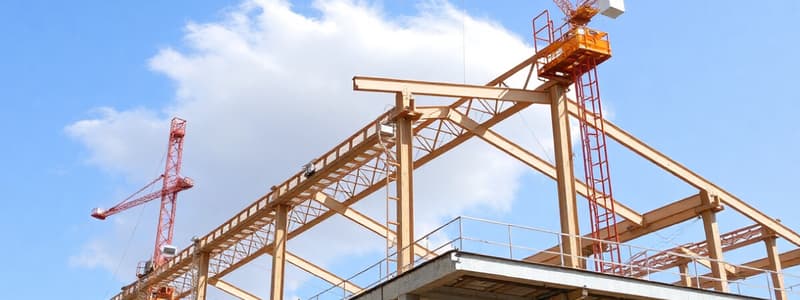Podcast
Questions and Answers
What does the exposure coefficient (k) primarily account for in wind load calculations?
What does the exposure coefficient (k) primarily account for in wind load calculations?
- The basic wind speed at a specific geographic location.
- Variations in wind pressure with changes in height above ground level. (correct)
- Changes in wind pressure due to the building's shape.
- The effect of surrounding buildings on wind speed.
What is the primary determinant of the basic wind pressure (q) on a structure, according to the provided information?
What is the primary determinant of the basic wind pressure (q) on a structure, according to the provided information?
- The basic wind speed at the building's location. (correct)
- The exposure coefficient.
- The height of the structure.
- The wind pressure distribution factor.
According to the document, what is the value of the ratio\factor of safety, $M_{stability}/M_{overturning}$, to consider a structure stable?
According to the document, what is the value of the ratio\factor of safety, $M_{stability}/M_{overturning}$, to consider a structure stable?
- Greater than 1.5 (correct)
- Greater than 1.0
- Less than 1.5
- Less than 1.0
When calculating wind load, the wind pressure distribution factor ($C_e$) varies based on which of the following?
When calculating wind load, the wind pressure distribution factor ($C_e$) varies based on which of the following?
Under what condition is the structure's coefficient taken as 1.00?
Under what condition is the structure's coefficient taken as 1.00?
Which of the following descriptions best characterizes an 'open exposure' area when determining the exposure coefficient (k)?
Which of the following descriptions best characterizes an 'open exposure' area when determining the exposure coefficient (k)?
What does the structural factor ($C$) account for particularly in variable wind loads?
What does the structural factor ($C$) account for particularly in variable wind loads?
What is the significance of determining the 'Total Moment at base' in the context of wind load analysis?
What is the significance of determining the 'Total Moment at base' in the context of wind load analysis?
What formula estimates Sliding Force?
What formula estimates Sliding Force?
What would be the design consideration for structures in areas prone to both wind and seismic loads?
What would be the design consideration for structures in areas prone to both wind and seismic loads?
Which factor considers the influence of terrain undulations on wind pressure?
Which factor considers the influence of terrain undulations on wind pressure?
What does the term 'turbulence' refer to in the context of structural factor ($C$)?
What does the term 'turbulence' refer to in the context of structural factor ($C$)?
What does the wind load (F) depend on?
What does the wind load (F) depend on?
When defining load combinations involving wind load (WL), what should be considered according to the document?
When defining load combinations involving wind load (WL), what should be considered according to the document?
Which type of structure would typically require a wind tunnel test or complex simulations for a detailed analysis of wind dynamic effects?
Which type of structure would typically require a wind tunnel test or complex simulations for a detailed analysis of wind dynamic effects?
Which of the following statement is true regarding the factor termed 'α'?
Which of the following statement is true regarding the factor termed 'α'?
What primarily determines the selection of the appropriate analysis method for wind dynamic effect?
What primarily determines the selection of the appropriate analysis method for wind dynamic effect?
Which factor is LEAST likely to influence the external wind pressure coefficient ($C_e$)?
Which factor is LEAST likely to influence the external wind pressure coefficient ($C_e$)?
When should a structural engineer consider the effects of turbulence in wind load design?
When should a structural engineer consider the effects of turbulence in wind load design?
What does the 'area' symbolize in Wind load (F) = $C_e$ x k x q x area?
What does the 'area' symbolize in Wind load (F) = $C_e$ x k x q x area?
Flashcards
Pe
Pe
External wind pressure statically affecting the unit area of external building surfaces.
q
q
The basic wind pressure which relies on geographic location
k
k
Exposure coefficient that varies with height above ground level
Ce
Ce
Signup and view all the flashcards
Exposure Factor (K)
Exposure Factor (K)
Signup and view all the flashcards
Open Exposure (Category A)
Open Exposure (Category A)
Signup and view all the flashcards
Suburban Exposure (Category B)
Suburban Exposure (Category B)
Signup and view all the flashcards
City Center Exposure (Category C)
City Center Exposure (Category C)
Signup and view all the flashcards
V (Wind Speed)
V (Wind Speed)
Signup and view all the flashcards
P (Air Density)
P (Air Density)
Signup and view all the flashcards
C (Topography Coefficient)
C (Topography Coefficient)
Signup and view all the flashcards
C (Structural Factor)
C (Structural Factor)
Signup and view all the flashcards
Wind Load (F)
Wind Load (F)
Signup and view all the flashcards
Wind Distribution
Wind Distribution
Signup and view all the flashcards
Resisting force
Resisting force
Signup and view all the flashcards
Alpha
Alpha
Signup and view all the flashcards
Study Notes
- Wind Load Calculation is covered in Lecture 5 by Mohamed Abdelbarr, Ph.D., P.E.
Wind Load Calculation Formula
- External wind pressure statically affecting the unit area of external building surfaces is denoted as Pe, using the following formula:
- Pe = Ce * k * q
Variables
- Pe is the external wind pressure.
- q represents the basic wind pressure that is dependent on the building's geographical location. Values for q are based on what is in item (7-4).
- k refers to the exposure factor which varies with height above ground level. Values for k come from item (7-5-3).
- Ce is the external wind pressure coefficient on building surfaces, dependent on the building's geometry. Values for Ce are based on item (7-6).
Wind Pressure Distribution Factor (Ce)
- Wind Pressure Distribution Factor (Ce) varies based on location around the structure
- Ce can be negative or positive depending on face
- Wind Pressure Distribution Factor (Ce) can be calculated as Ce = 0.8 + 0.5 = 1.3
Exposure Factor (K)
- Exposure Factor (K) defines the change in wind with height
- Exposure Factor (K) gradually increases as height increases from the ground
- Areas for calculating the exposure have three categories based on ground roughness length
Exposure Category Types:
- Exposure (A): Includes open, exposed areas with few obstructions.
- Exposure (B): Includes areas with moderate obstructions, such as small towns and suburban areas.
- Exposure (C): Includes areas with significant and closely spaced obstructions like city centers.
Wind Pressure (q)
- Basic wind pressure (q) in kN/m² can be calculated using the formula: q = 0.5 * (rho) * V^2 * C * C
- V is the basic wind speed corresponding to a 3-second wind gust at a height of 10m above ground, per table (7-1), with a 2% probability of exceedance for design loads over 50 years
- (Rho) is air density, taken as 1.25 kg/m3
- Constant (C) represents the ground topography, based on the shape of the land and its undulations, table (2-7)
- Constant (C) represents the building and is calculated based on the annex (أ)
Defining the Constant C
- Constant C takes into consideration the impact of wind loads during peak, non-sequential occurrences of peak wind pressure on the building, along with the building's disturbance during turbulence.
- For detailed analysis of wind's dynamic effect, a wind tunnel test is performed, or complex simulations
Structural Factor
- Structural factor accounts for the impact of wind loads during non-sequential peak wind pressure on the building
- Structural factor also accounts for the building's vibration during turbulence
Conditions for Structural Factor Value
- Structural factor value is 1.00 in these situations:
- Buildings and structures less than 60 meters high
- Gabled (lattice) towers
- Buildings/structures with a height less than four times the smallest dimension in the horizontal plane
Wind Load (F) Equation
- Wind Load (F) = Pe × area
- KN = Ce x k x q x area
- Area = area subjected to wind
Wind Distribution Formula
- Wind distribution is measured as Pe = Cex kx q kN/m²
Wind Distribution Table
- Zone A is most critical case
- P4 = Cex K 4x q, k 4=1.60
- P3 = Cex k3x q, k 3=1.40
- P2 = Cex k2x q, k2=1.15
- P1 = Cex k₁x q, k₁=1.00
Additional Formulas
- F=Cex kx qx area
- Total Moment at base = Σ Fix Hi
- M overturning = F1x H1+Fx H2+F3x H 3+
Further Equations
- Factor Of Safety = Stability Moment / Overturning Moment
- F.O.S. = Mstability / Moverturning
- Sliding Force =Fb / 1.40
- Resisting Force = µ ×W
- Factor Of Safety= Resisting Force / Sliding Force
- F.O.S. # 1.5
Load Combinations
- In circumstances where the facility is exposed to wind and earthquake loads, you must use the ultimate Load (U).
- Use the larger value calculated from the equations below.
- U = 0.8 [1.4 D.L. +1.6 L.L. +1.6 W.L.]
- U-C = 1.12 D.L. + a L.L.+S.L.
- U = 1.4 D.L. + 1.6L.L
- Value of (0) must not be lower than this value.
Variable List
- D.L. = Dead load
- L.L. =Live load
- S.L. = Seismic load
- W.L. = Wind load
- Variable (α) superimposes the effect of quasi-permanent vertical loads above to the facility during an earthquake. (α) depends on the type of facility.
Variable (α) Values
- Residential buildings = 0.25
- Public facilities (such as non-main warehouses, commercial markets, schools, hospitals, garages) = 0.50
- Structures loaded w/ sustained/continuous activity (such as libraries, main warehouses, garages) = 1.00
Computer Modeling
- For computer aided design, static load case names must be defined
Studying That Suits You
Use AI to generate personalized quizzes and flashcards to suit your learning preferences.




